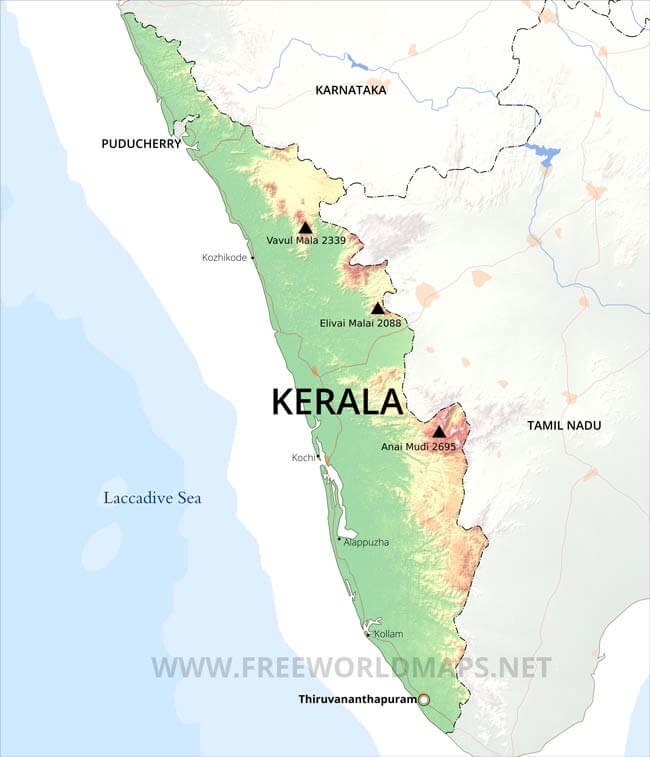
I am on a journey across southern India with my driver, Nishad, in a white Toyota. We have driven from Chennai on the east coast viewing the astounding temples of Tamil Nadu. The last of these was the holy temple of Meenakshi Sundareswarar in Madurai. Time now to take the long weary road westwards towards Kerala.
After some hours we arrive at a ‘grape farm’, where I stagger out of the car. Some grape vines in neatish rows bear small red and green grapes. Gulp down a welcome cup of freshly liquidised grape juice. A sleepless night followed by hours sitting in a car is not my idea of entertainment, despite the odd stop for bird spotting. On the plus side, however, the scenery is becoming greener. Much land that we have passed so far has been barren and nondescript but, as we weave up the lower hills of the Western Ghats, dense verdant patches and flowers brighten up the vista. Some very large pipes appear, which I am informed are used to supply water to Tamil Nadu from Kerala. And, as we descend the hills the other side, Nishad tells me happily that we have arrived in the state of Kerala, “Land of Coconuts”. This is his home territory. The car number plates change from TN to KL and other differences soon become apparent. It is wealthier, cleaner, and there are several huge gleaming churches in wayside towns. Even the dress is different. Many women for example, are not wearing saris, rather tunics over trousers.
Periyar Wildlife Sanctuary
The Periyar Wildlife Sanctuary, a reserve for tigers, is the first stop in Kerala. Way up in the Cardamom hills, it is an area where endemic species of flora and fauna thrive, and was first declared a reserve to halt the expansion of tea plantations. In the reserve is a large artificial lake, Lake Periyar, created by the British in 1895 by damming the River Periyar with the Mullaperiyar dam to produce a reservoir. The waters are mainly diverted to Tamil Nadu which, being in the rain shadow of the Western Ghats, lacks precipitation. Hence those pipes I glimpsed from the car window earlier.
We arrive in the carpark and I board a bus, taking visitors to the lake. On arrival we file down walkways and are loaded onto boats. A bulky bright orange buoyancy aid is thrust upon me as the fleet sets off. Sambar deer are spotted, one with huge antlers sitting on a grassy bank in the shade, wild boar and birds, including a woolly necked stork, egrets, cormorants and red wattled lapwings. There are forests all around the lake and the hills yonder are reflected in the still blue water. It all seems very distant from the temples and chaos of Tamil Nadu and it is the first time I have felt cool since arrival in India.
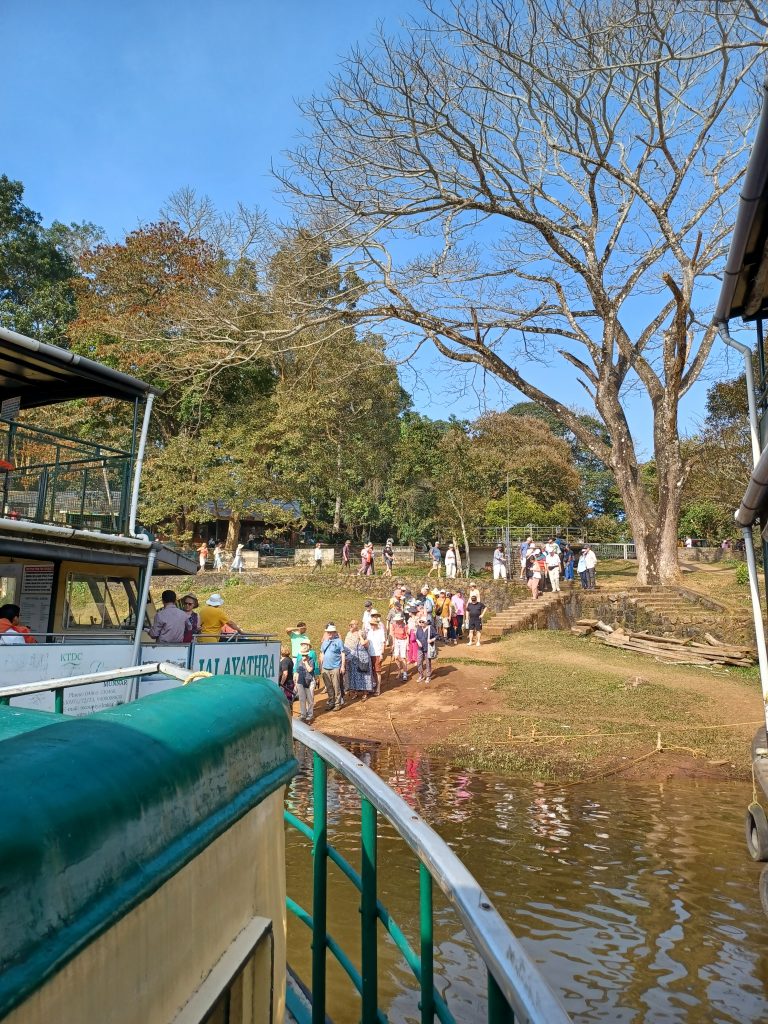
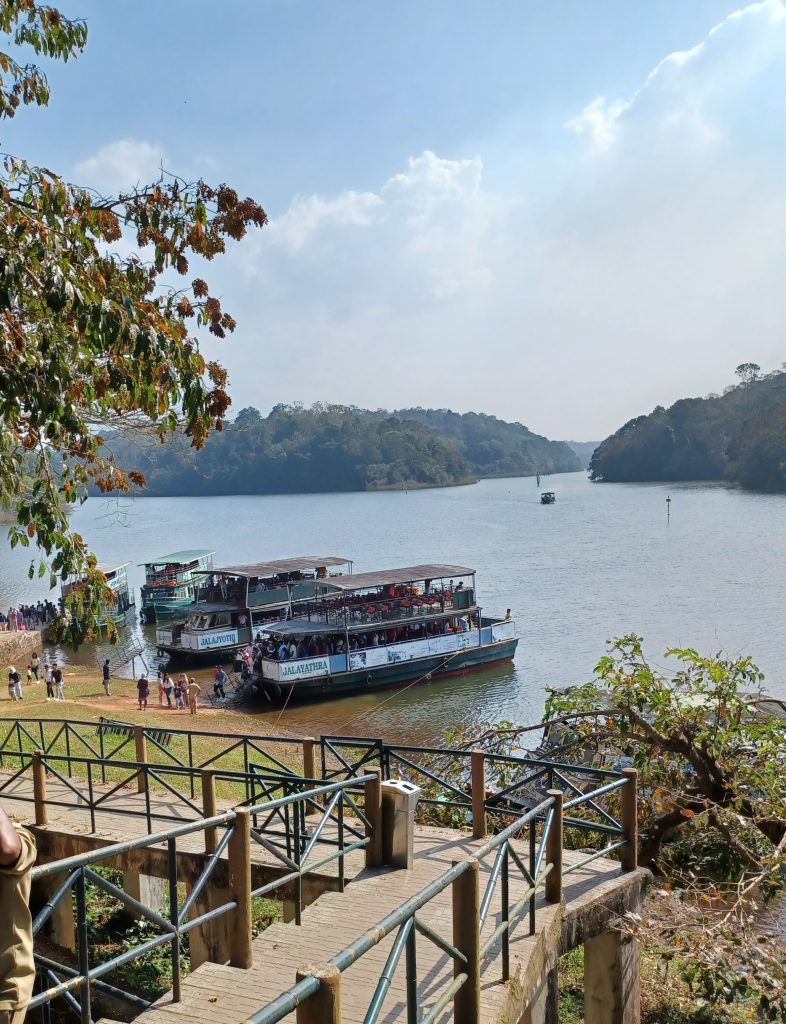
Contrary to my normal habit, I heave myself out of bed at 0600 next day to participate in a nature walk. Lake Periyar in the early morning mist is sublime. Despite the early hour and the lengthy time hanging about and having to fill out an indemnity form in case I am charged by elephants or fall into the lake, I am in cheerful mood. The six or seven of us with our park rangers are presented with leech protectors, which we slip over our socks and up to our knees. I watch as a group, dressed in the same bulky buoyancy aids as yesterday, is pulled across a short stretch of water on a bamboo raft by means of a rope ‒ attached to both banks. I follow with my personal tracker.
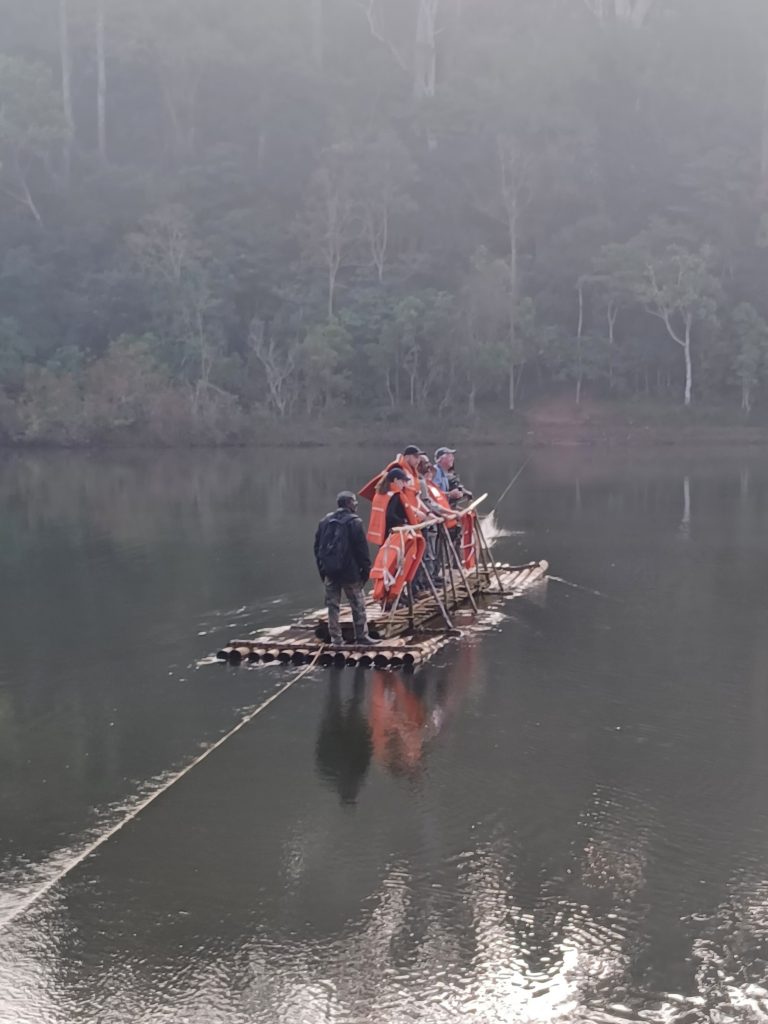
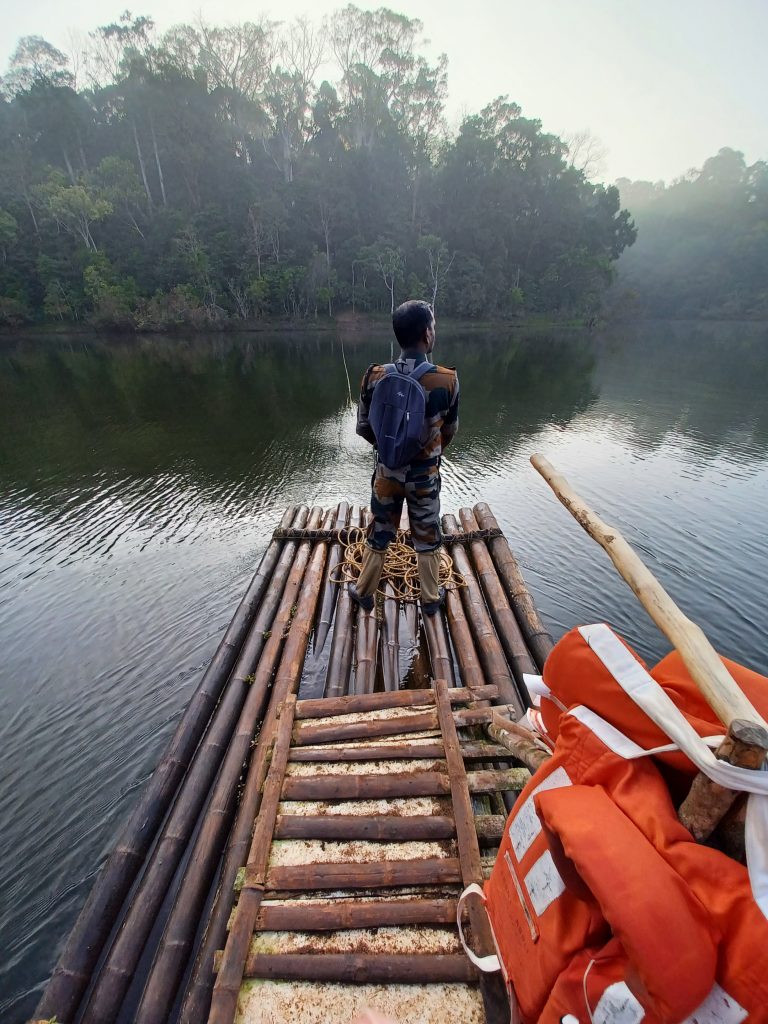
Once in the forest we stop and listen, binoculars at the ready. Said tracker spots birds far sooner than I and is soon pointing out a Malabar grey hornbill, some grey jungle fowl lurking about in the low shrubs, a white bellied woodpecker with its red crest, and Brahmini kites circling above the tree tops. A langur monkey, black with very long tail and ginger hair on its head scampers up a tree with its infant. A Malabar giant squirrel perches on a low branch eating leaves, its black bushy tail dangling below. No elephants or tigers in sight though. Probably just as well. Shame to return down the trail to the raft really. The birdsong is soon drowned out by the chug-chug of engines as the fleet of boats that I was part of yesterday is now manoeuvring in and out of the pretty mooring area, the early mist has melted away, and the sun’s rays glance across the waters.
Spice plantation
I take the bus back to the carpark where Nishad awaits. Whilst I was footling about in the undergrowth he was cleaning the car. Splendid. Shiny and bright it looks. He opens the door for me with a flourish. “Now we visit spice plantation”, he informs me.
This should be interesting. Indian spices were coveted by western traders in those early days of exploration and colonisation. Many spices flourish here. I am led swiftly from one spice tree/bush/plant to another, the guide thrusting samples one by one in front of my nose to sniff at. First a vine full of hard green Malabar peppercorns. Malabar pepper originated in Kerala I am told. The green, white and black pepper varieties come from the same plant but are processed differently. Pepper was once the king of spices, a luxury good, responsible for luring those first traders, the Portuguese, Dutch and British in particular, who fought over the trade.
Vanilla next. An expensive spice. “Here in Kerala the vanilla is hand pollinated. Very labour intensive”. This explains the high cost. The guide shows me how to test for the best vanilla by wrapping it round his finger. “If it cracks it is no good as the oil has come out”. Next up is nutmeg. I had been watching Joanna Lumley’s ‘Spice trail’ series recently in which she had been recounting the trade in nutmeg from the Banda Islands of Indonesia. The British and the Dutch had several conflicts over these Spice islands in the seventeenth century until the Dutch traded Manhattan island (in New York) with the British in order to secure a monopoly on the trade and built massive forts to protect it. A brutal and bloody period in which many, particularly local islanders, were massacred. Pointless too because the British uprooted some of the seedlings and replanted some here in India.
Many other spices including cardamom, native to India and the third most expensive spice today after saffron (grown in Kashmir) and vanilla; cloves (“good for toothache”), cinnamon, coffee beans and turmeric are held up for my inspection. “Turmeric is very medicinal”, I am informed, “for colds and indigestion”. “The main ingredient, as well as the colour, in curries”. The harvesting period for turmeric is presently over but the guide points out a rhizome, with its yellow inside exposed, abandoned on the ground.
After the tour, inevitably, I am led to the shop selling the spices to willing, or not so willing, tourists. Purchase many, including some ginger sweets, which may help to ease the queasiness in the car. Beg a cup of tea and sit sipping it amidst the spicy odours of the shop.
Kathakali
As the afternoon wears on I begin to get stomach cramps. I am fairly firmly convinced that these cramps are a result of something rotten I have eaten, ergo: food poisoning ‒ having experienced similar symptoms several times before in countries as diverse as Tanzania, Algeria, Croatia and even France. The night before I had broken my ‘vegetarian only in India’ rule, by eating chicken soup, with bits of chicken floating about in it. I had supped it eagerly. Hmmm. This does not augur well for this evening’s plans: a Kathakali show.
Kathakali is a traditional show where the performers apply much make up and tell stories through their facial expressions and gestures. Ghastly though I feel I, even so, arrive early at the venue to see make up being applied to the main demon in the story: thick layers of green on his face and thick layers of red on his lips. All rather lurid. The demon struts and frets his few minutes upon the stage and is shortly followed by a man dressed as a woman doing something similar. The show is accompanied by a constant drum beat and frequent clashes of cymbals, which send shock waves throughout the building, and is deafening. And I am in the front row. The best seat in the house. I survive it somehow after which I summon Nishad to take me back the ten kilometres to the hotel. I miss an ensuing martial arts performance. Small mercies.
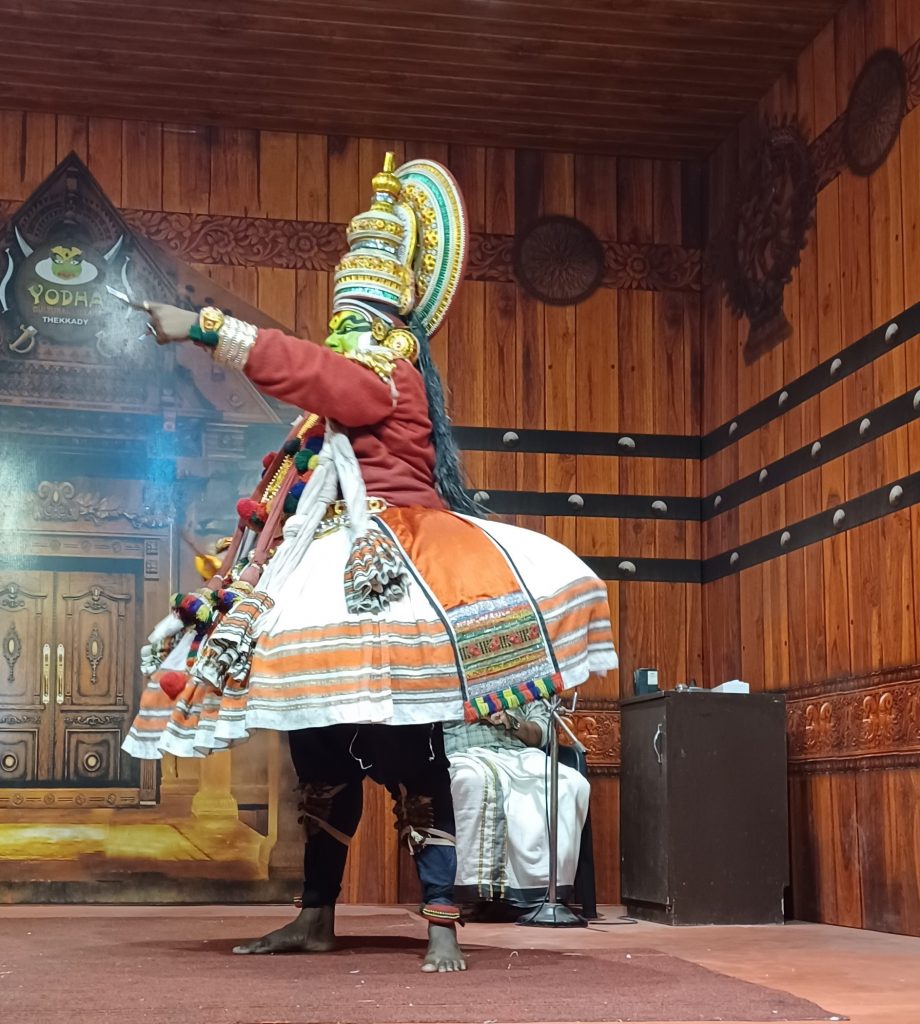
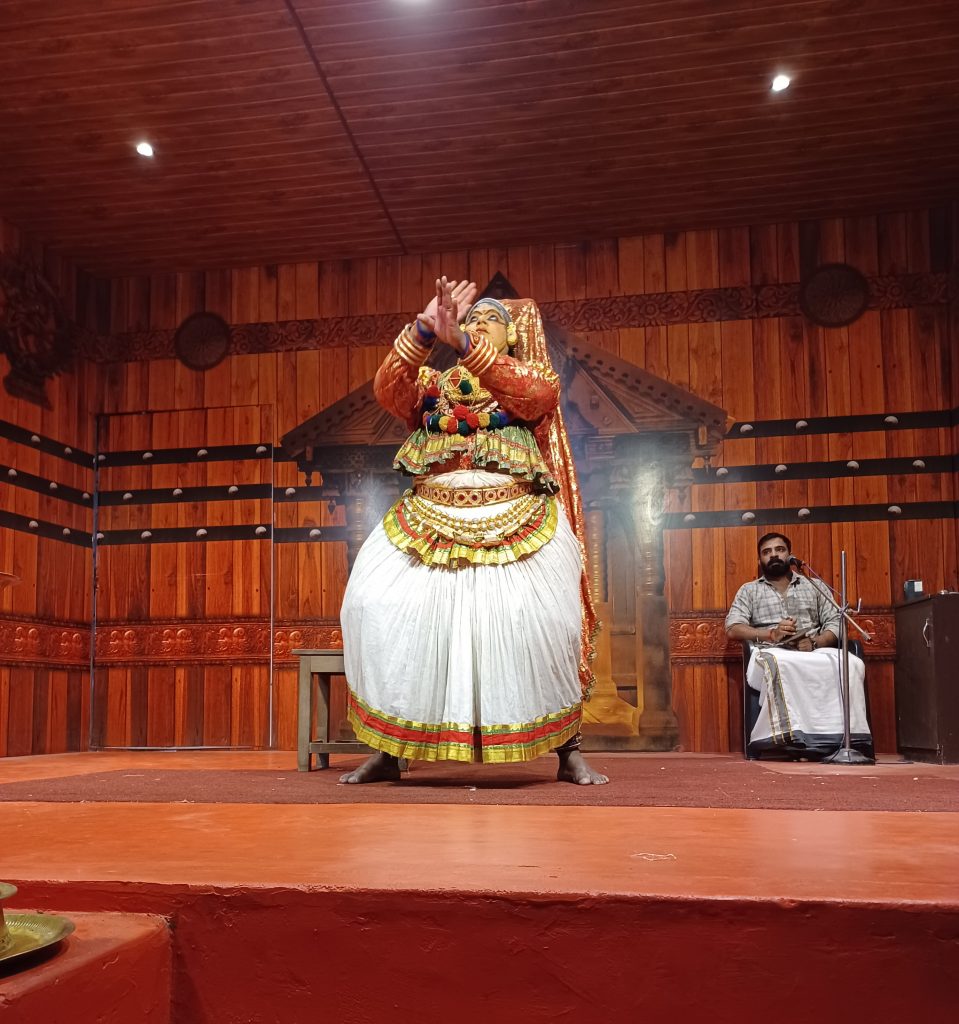
Munnar
However, I don’t feel so bad today, although we drive on stomach churning roads to the tea plantations of Munnar. We stop at a roadside shack for coffee on the way. The proprietor pours the coffee into a cup from a great height, wipes the drips away with his thumb and brings it to the table. I sup it slowly while Nishad chomps a banana fritter, a large one. I decline to indulge. A quick leg stretch and I am back in the car. The scenery is stunning: large lakes, and hills carpeted with tea plants. And a huge statue of Ganesha in a wayside village.
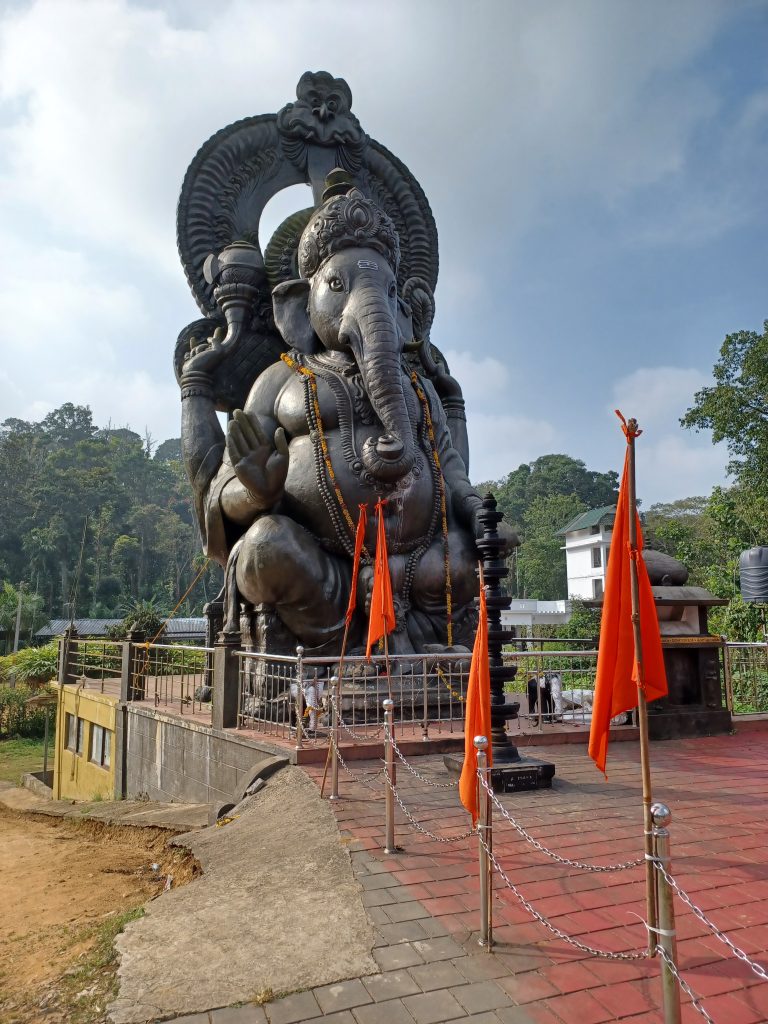
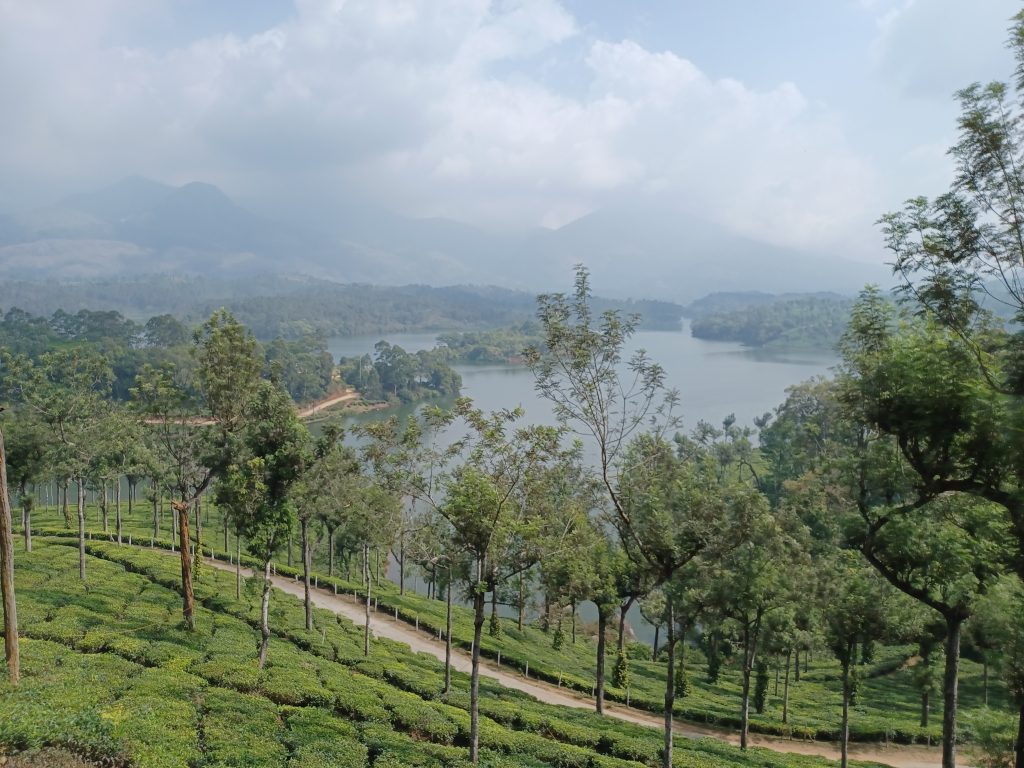
The story behind the Indian tea plantations is intriguing. The British first acquired their taste for tea after tea was exported to Britain from China. However, they were obliged to pay for it in silver because the Chinese were unenthusiastic about any goods offered in exchange. Eventually the British found a product which was desired ‒ by some anyhow: opium, which was grown in India, and shipped to China. This trade eventually resulted in the notorious opium wars with China. Anyway, at some point, Chinese tea plants were smuggled into India and first planted in Assam. Ironically some decades after planting the Chinese tea, some native wild Indian tea plants were found and subsequently planted. They thrive exceedingly well on the Kanan Devan Hills around Munnar.
In Munnar’s interesting Tata tea museum I watch a batch of tea being processed, rattling through the old nineteenth century machinery. I read about the history of the area. Colonel Arthur Wellesley, aka the Duke of Wellington, visited the Kanan Devan Hills with a troop of soldiers in 1790 while attempting to ‘annihilate’ Tipu Sultan, the ruler known as the ‘Tiger’ of Mysore, a thorn in the side of the British, I understand. Another British soldier, General Douglas Hamilton, came here in 1862 seeking convalescent stations for his troops. He described the terrain as ‘surpassingly grand and incomparably beautiful’.
The British built a railway network in Munnar in the early 1900s to serve the plantations. Rail journeys, it seems, were hampered by recurrent derailments as well as elephants crossing the track. In fact the original roads into the tea growing areas were built on elephant tracks. Perhaps not a good idea. As we drive down the hill I see an ‘elephant crossing place’ notice. “Here are coming elephants,” remarks Nishad, but there are none in evidence today. Some weeks after my visit there was a fatal attack by an elephant in Munnar, the third such incident in Kerala in a month. There are 6000 wild elephants in Kerala apparently and such conflicts are becoming more frequent.
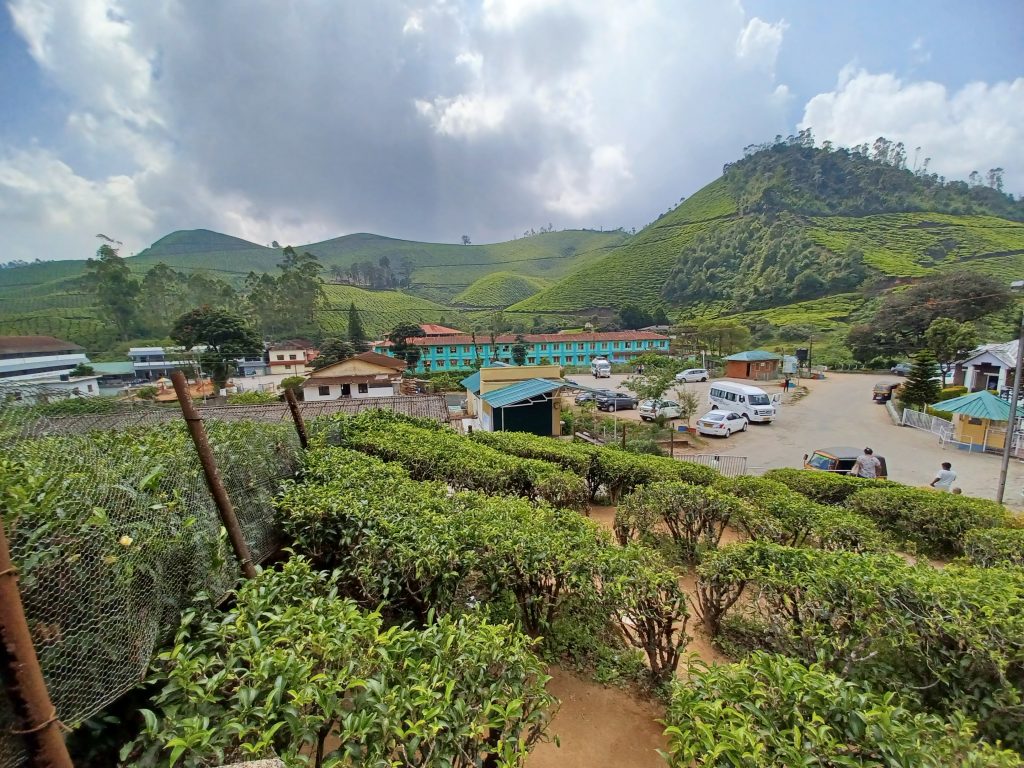
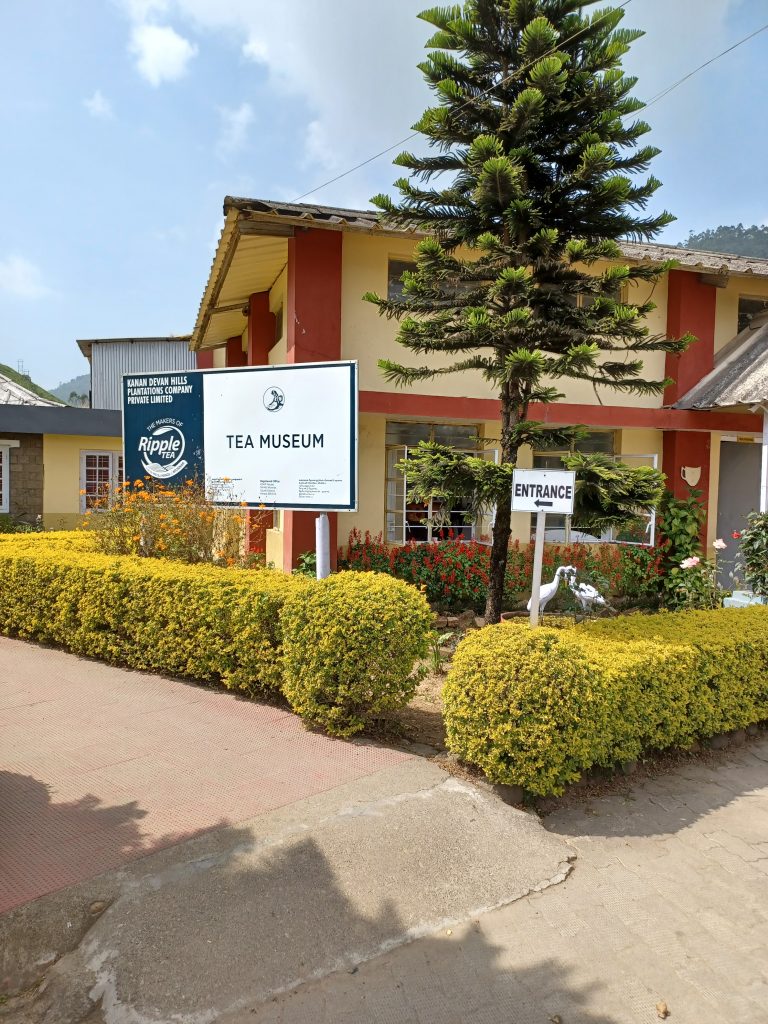
Close by the hill station are some workshops where a group of less abled people are making paper products out of elephant poop and other ingredients. I buy an elephant poop notebook. Novel. In another workshop batik is made and cloth is dyed. The money earned from these enterprises helps to support the community. The Misty Mountain Resort is my haven for the night and I watch the sun descend behind the misty Munnar hills.
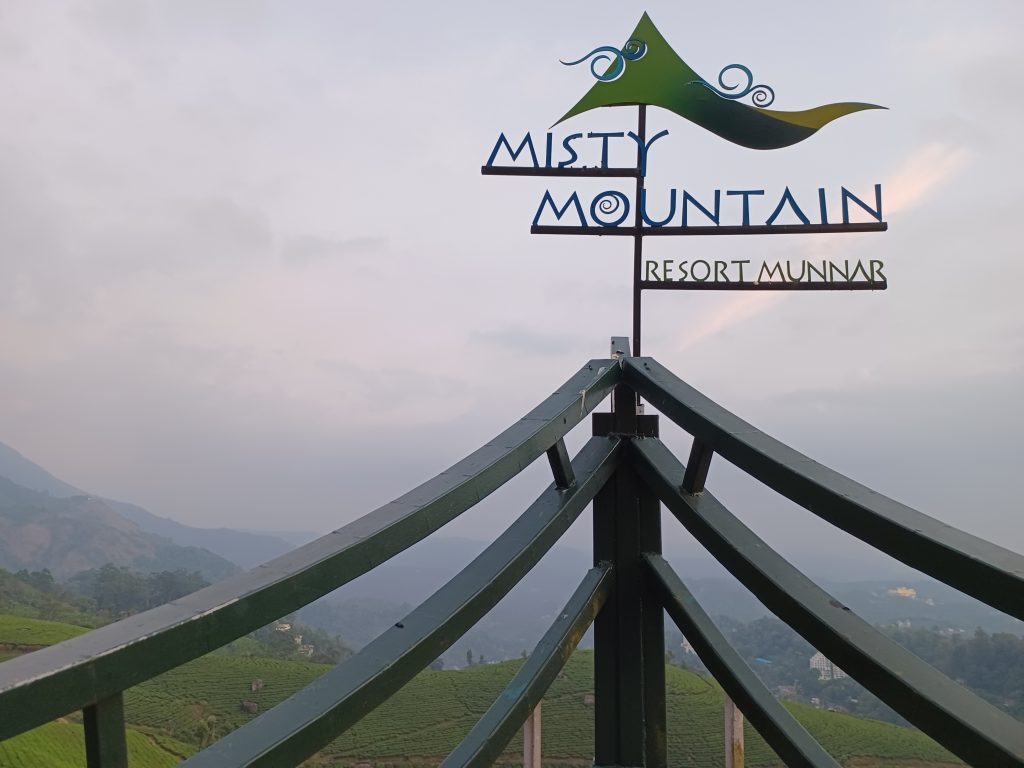
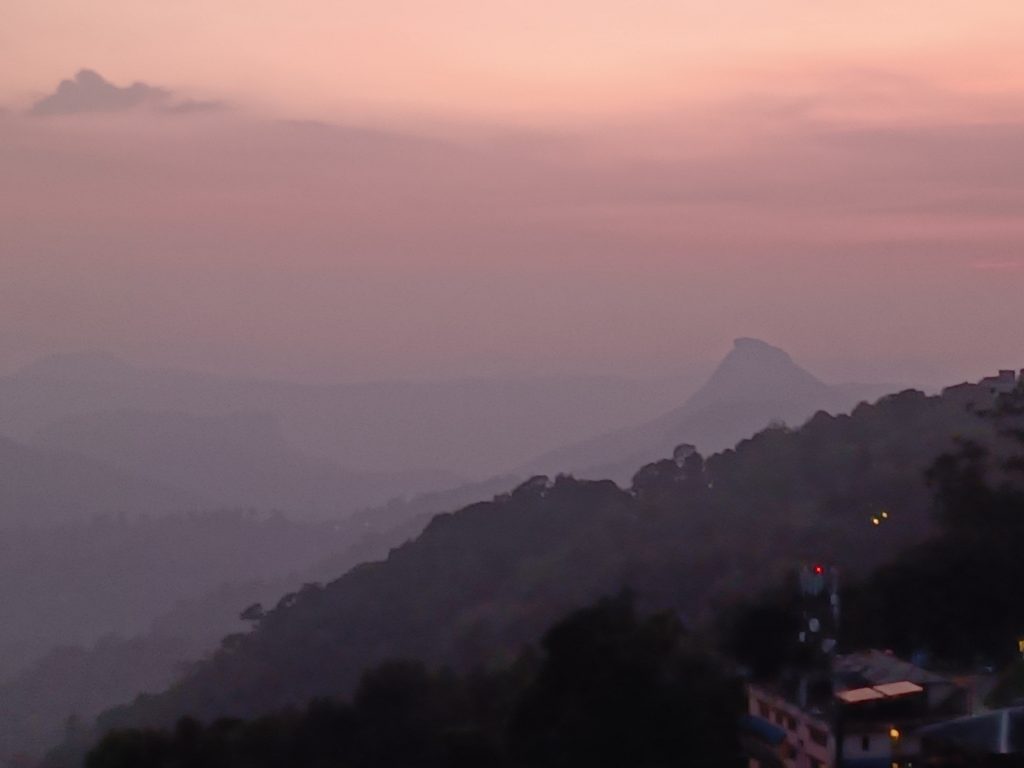
To the backwaters
There is some delay in leaving the misty mountain next day due to the tour company not having paid the bill for my night’s stay. So I am not permitted to leave. OK. The problem is shortly sorted. Apologies all round. And after half an hour we are driving from Munnar towards the backwaters for which Kerala is famous. We descend the hills through areas of luscious foliage, waterfalls, rubber plantations, plots of tall tapioca plants, and pineapple groves. A man is selling large tapioca roots at the roadside and we pass more magnificent white churches: St Francis Church and Christ the King Church, to name two. Their congregations must be well-heeled as the buildings are in such glossy condition. Villas in their painted luxury sit behind walls and locked gates. Many wealthy Indians live in Kerala. I notice more traffic lights, hardly seen since the chaos of Chennai, ‘No parking’ and ‘No littering’ signs. At a petrol station is a placard: ‘India Oil wishes you safe pilgrimage,’ and notices on walls advertise IELTS (International English Language Testing System) classes. And the streets are devoid of holy cows.
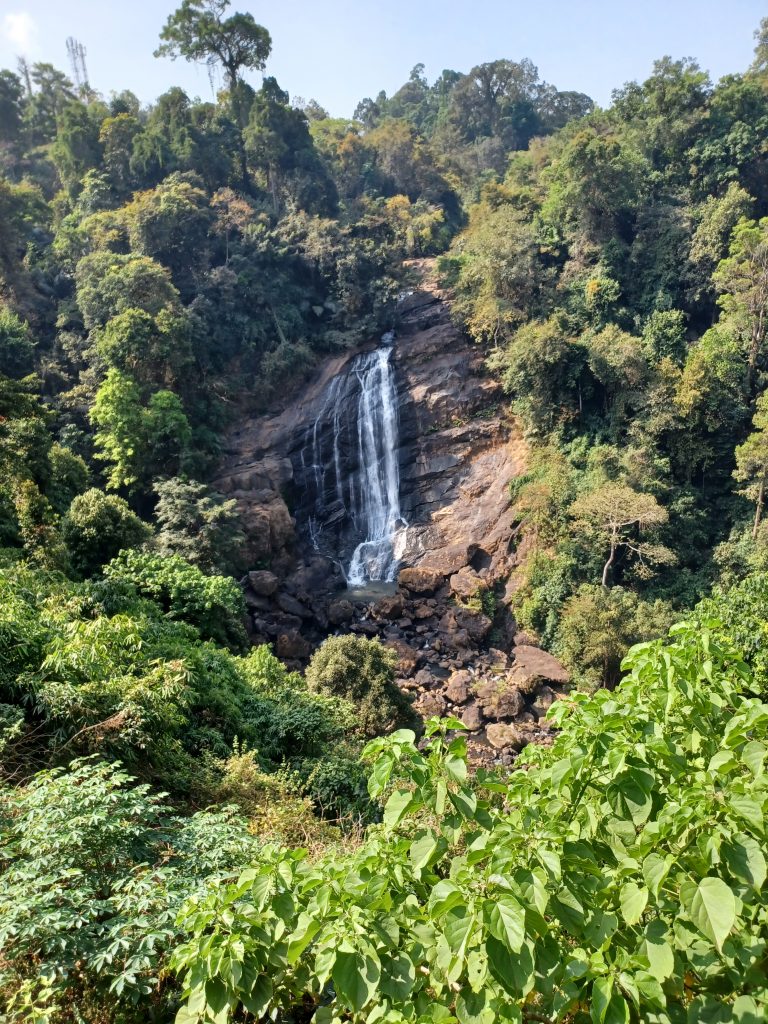
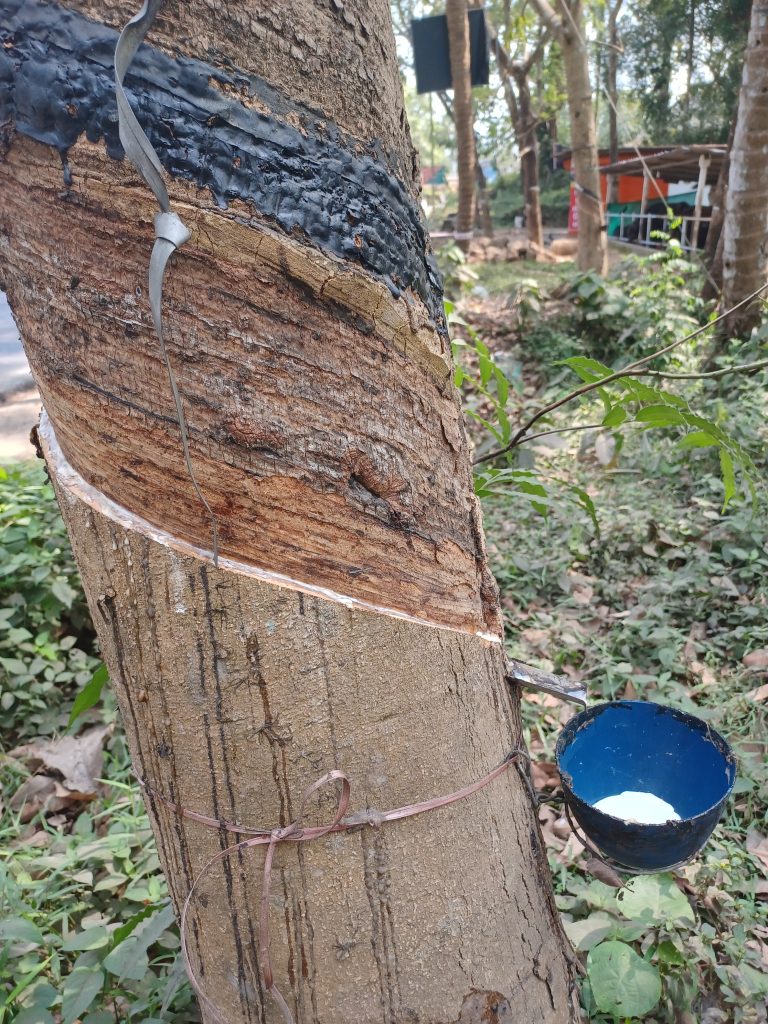
The Whispering Palm Beach Resort is my hotel this evening. I am greeted with a welcoming red dot on my forehead and a glass of mango juice from a sari-dressed lady in the spacious reception. The hotel backs onto Lake Vembanad, part of the Kerala backwaters, upon which hundreds of luxury houseboats, old rice boats called ‘Kettuvallam’, accommodate tourists and take them for boat trips. A couple of these boats have anchored amongst the pink water lilies on the lake. Egrets fly about, mynah birds whistle and house crows croak. I find a hammock and settle into it. Above is a coconut palm flush with coconuts. A net hangs underneath to prevent these mighty fruits from falling onto unsuspecting visitors below.
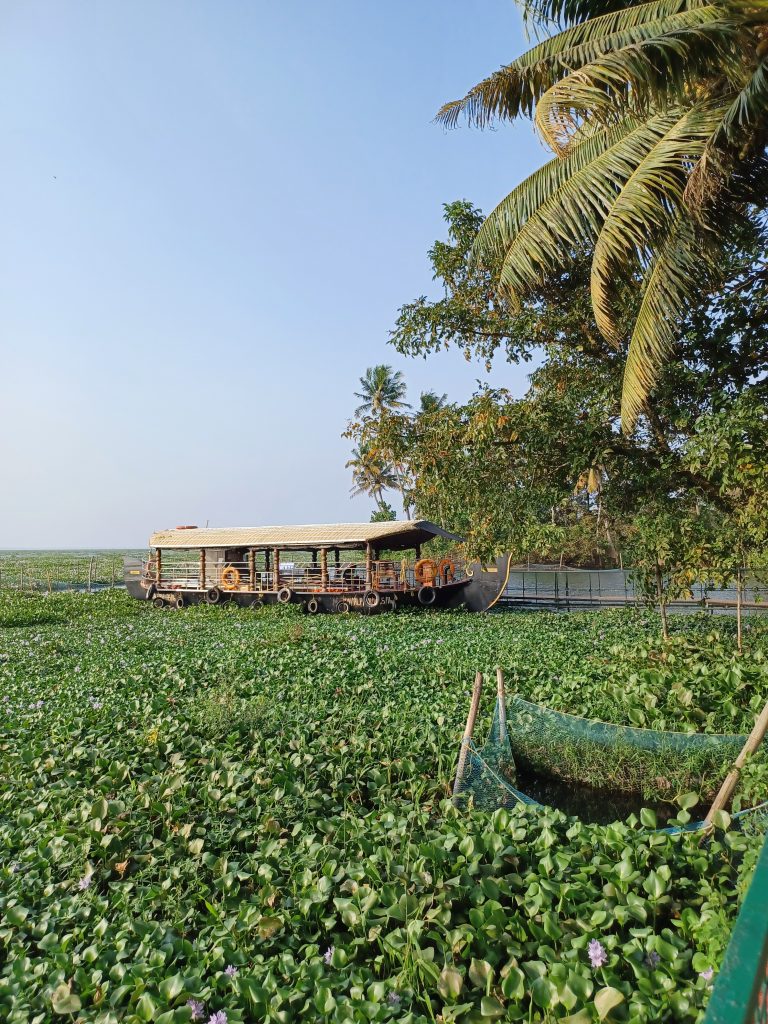
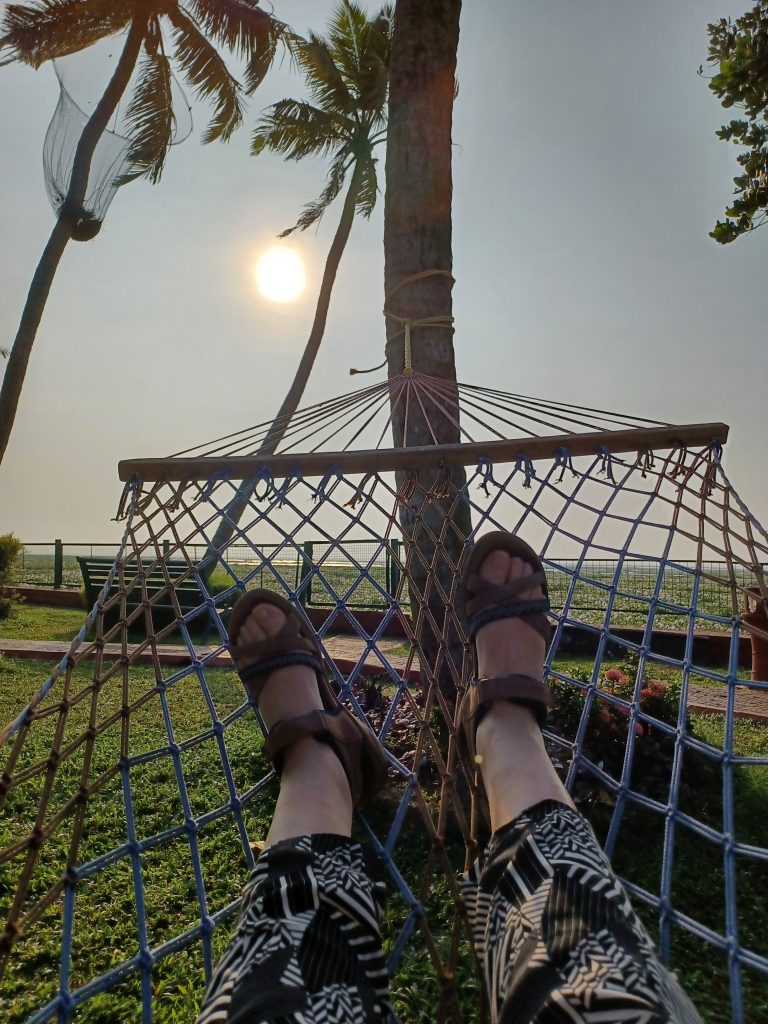
Alappuzha (Alleppey)
Kettuvallam Trip
So now it is time for one of the tour’s highlights: the night on a kettuvallam based in the backwaters at Alleppey, sometimes known as the ‘Venice of the East’. Can’t see the resemblance personally ‒ plenty of water but few buildings of consequence. As soon as I arrive a porter grabs my suitcase, heaves it onto his shoulder and guides me on the path past myriad houseboats of different sizes. I climb aboard my boat. I am the only passenger. I am hot, sticky and dusty, as the air conditioning in the car had ceased to work this morning and we were stuck in traffic for some distance in the heat. It takes some time for me to relax and recover as the skipper engages the throttle almost immediately and motors gently out.
But soon I am enjoying scanning the waters with my binoculars and admiring the boats, dozens and dozens of them, with wooden hulls and thatched rooves with bamboo frameworks. Some have an upper deck but mine is smaller with one main en suite cabin amidships and galley and crew’s quarters aft. A young chap is driving a bright yellow speed boat in between them. He creates a lot of wake but this doesn’t affect these steady, sturdy boats much. Just disturbs the peace. I am soon served lunch. I feel like a latter day memsahib with a skipper, crew and cook all looking after me. There is far too much foodstuff including a fish, fresh from the lake. I eye it ‒ in its fried form ‒ suspiciously. There is a curry of some sort, vegetables, rice, some unknown delicacies, a plate of pineapple and a basket of chapatis. Enough for multitudes. I make some sort of inroads into it, including picking at the fish, but there is a lot left over. Hope the crew will eat it. Mid-afternoon I am served tiffin. Tiffin is an old Indian English word for a snack, which came to mean afternoon tea in the days of the Raj. A large pot of tea and three huge banana fritters appear on the table. Too much sticky fritter and too little banana for my taste but it seems somewhat unkind not to eat one of them at least, so I force it down.
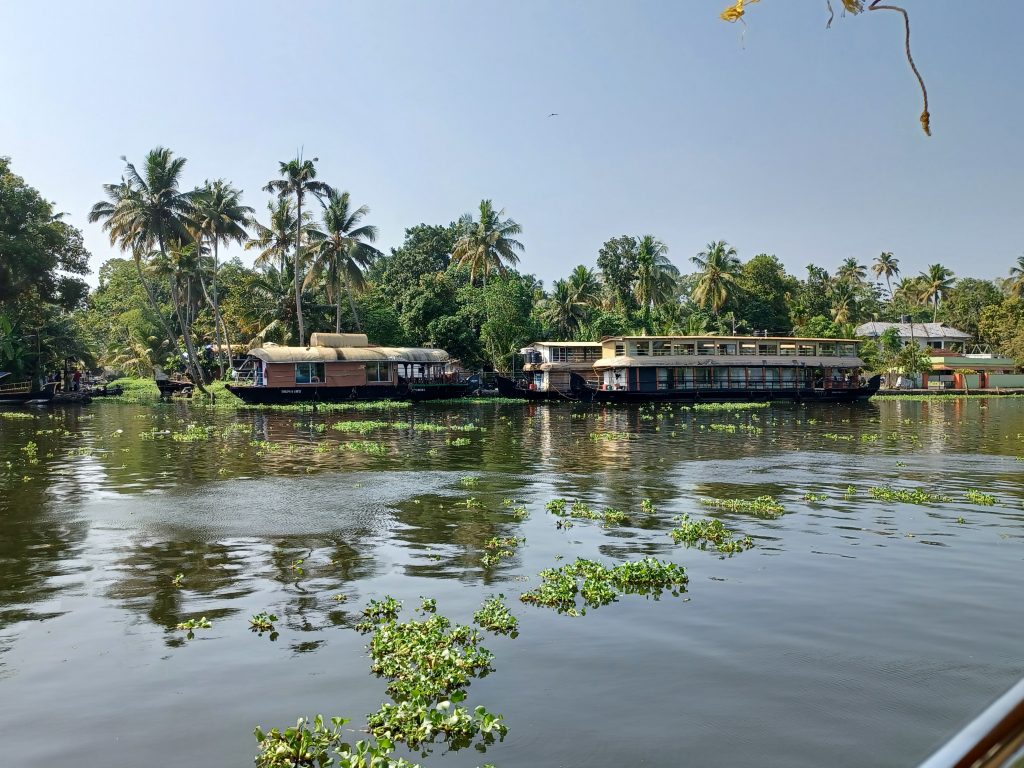
The skipper moors up in the early evening alongside a path by a lush lime green paddy field. I disembark for a stroll. The best time of day to see birds and I see all sorts of them not hitherto seen including a bright yellow black hooded oriole. In my element. I meet a German couple whose boat is moored close by mine and we compare experiences. Theirs has been similar to mine it turns out. Exhausted by all the driving they are grateful for the serenity of this place. They are also travelling by car. Wonder who sits in the back seat. I could not endure the back seat on these roads with the Indian driving style. After some while, I wander back to my boat where the crew is busily erecting mosquito nets around the topsides. These do not prevent the no-see-ums getting in though, those tiny little critters that settle on your dinner plate, upon which I am soon scooping portions of another huge meal. Retire to my cabin and have a shower. The cabin is cool, mosquito free and, apart from no toilet paper, everything is top-notch. Early night. Perchance to sleep.
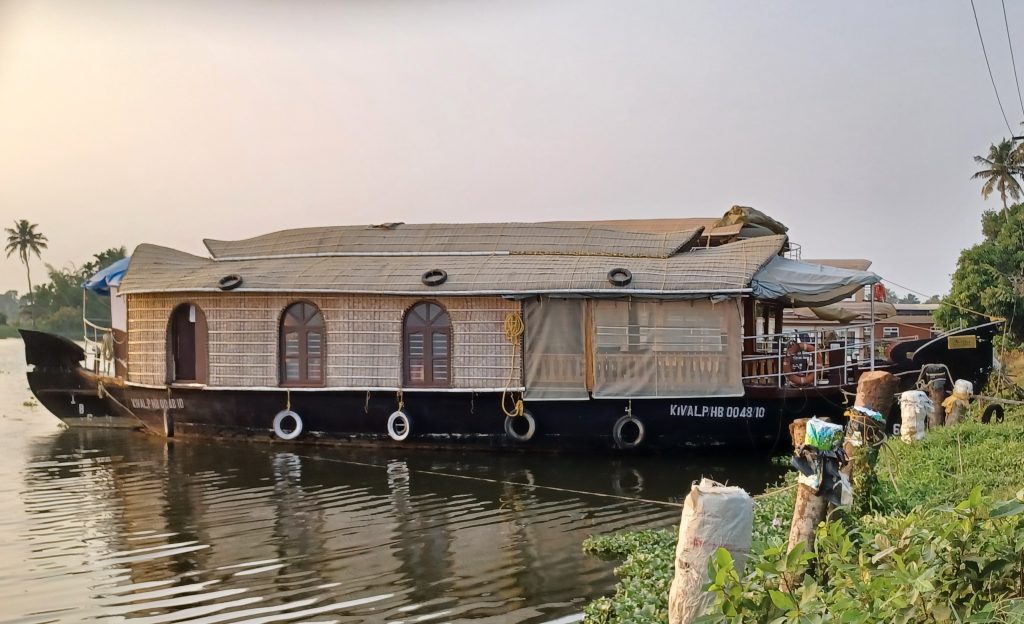
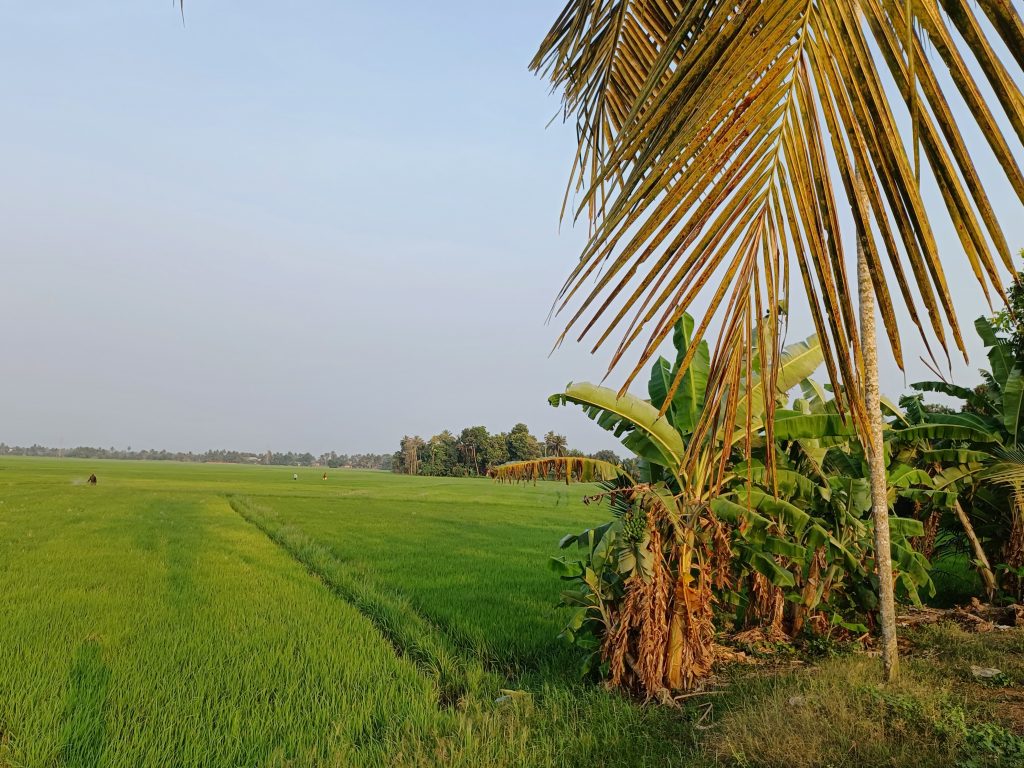
It is Sunday. I wake up early. I nip off for a walk before the mozzy nets are taken down and try to wear off the food which I shall shortly be obliged to eat. Wonderful walk. Early risers are washing in the lake, birds are in full song, palm trees rustle, and paddy field workers are doing things with rice plants. Some boats are already drifting slowly along and the low sun’s rays shimmer on the waters. When I return the red and white check tablecloth is full of breakfast. Sigh. An omelette is produced, a pancake stuffed with banana and coconut, and various other sweet things. The skipper returns from a church service. He is a Christian. There are many Christians – and Muslims – as well as Hindus in Kerala. After breakfast, I ask if I can take the wheel. Surprised look. I steer for 20 minutes or so. On cloud nine! The boat is easy to handle. Rather nice teak wheel too. I follow a bunch of boats back towards the base at Alleppey. Fabulous! Not looking forward to returning to the car.
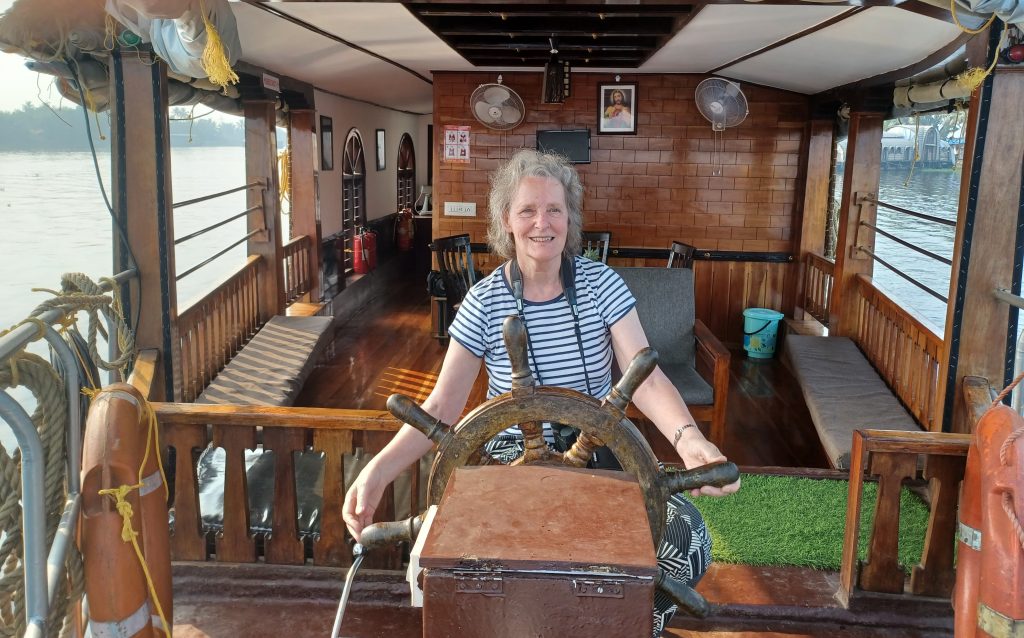
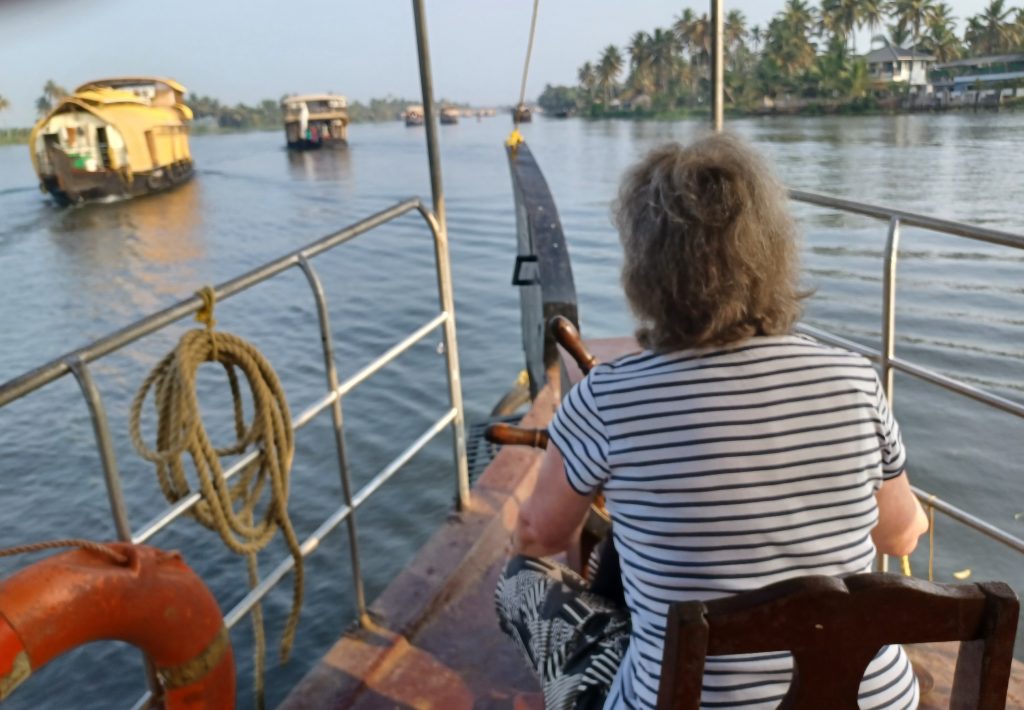
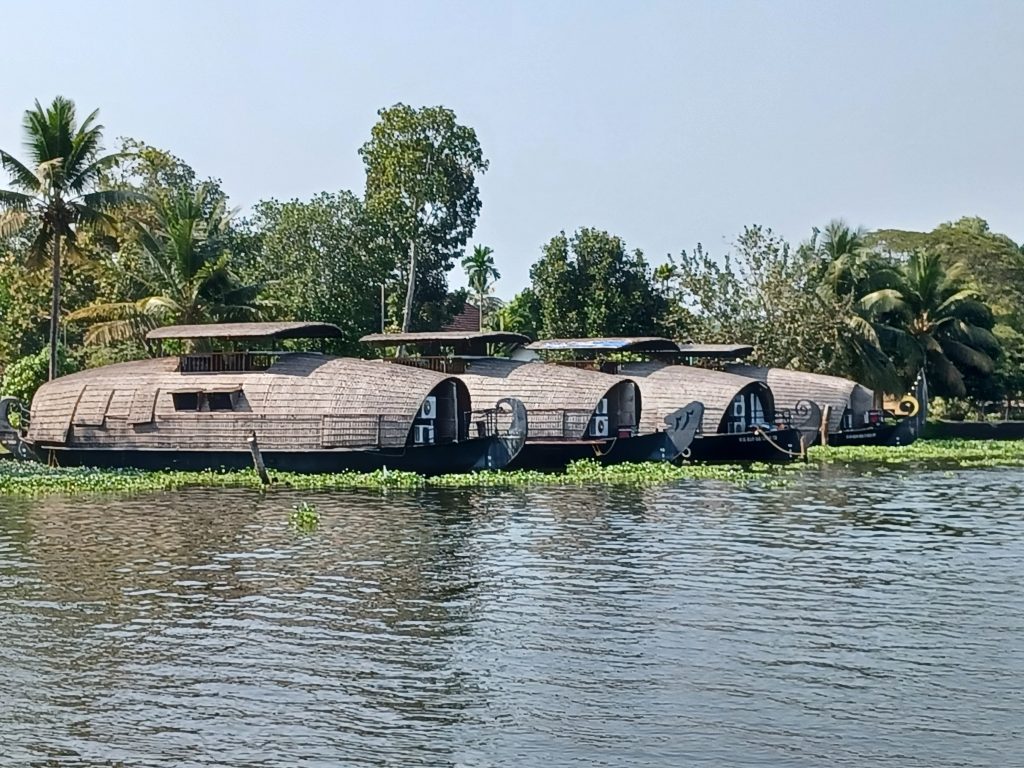
Alleppey Lighthouse and beach
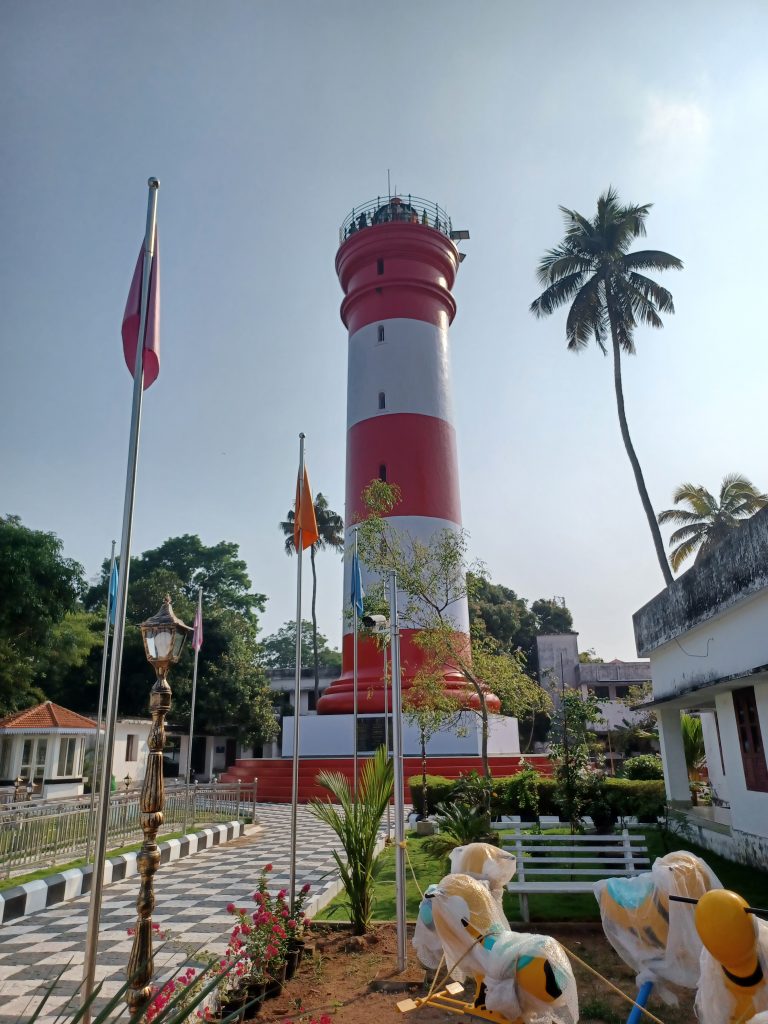
On the road again, but the car’s air conditioning is now working. No small solace. We are on the way to Kochi now but before leaving Alleppey, we stop at the Alleppey lighthouse. Built by the British in 1862, and shiny with its red and white stripes, it was installed here as a navigation aid for shipping on the trade routes from India to Europe. After being cornered by three different groups of selfie takers who wish to include me posing awkwardly at the lighthouse base, I am able to walk, barefoot and un-accosted, up the spiral teak staircase to the top. Glorious view over the Arabian Sea and houses dotted amongst the trees.
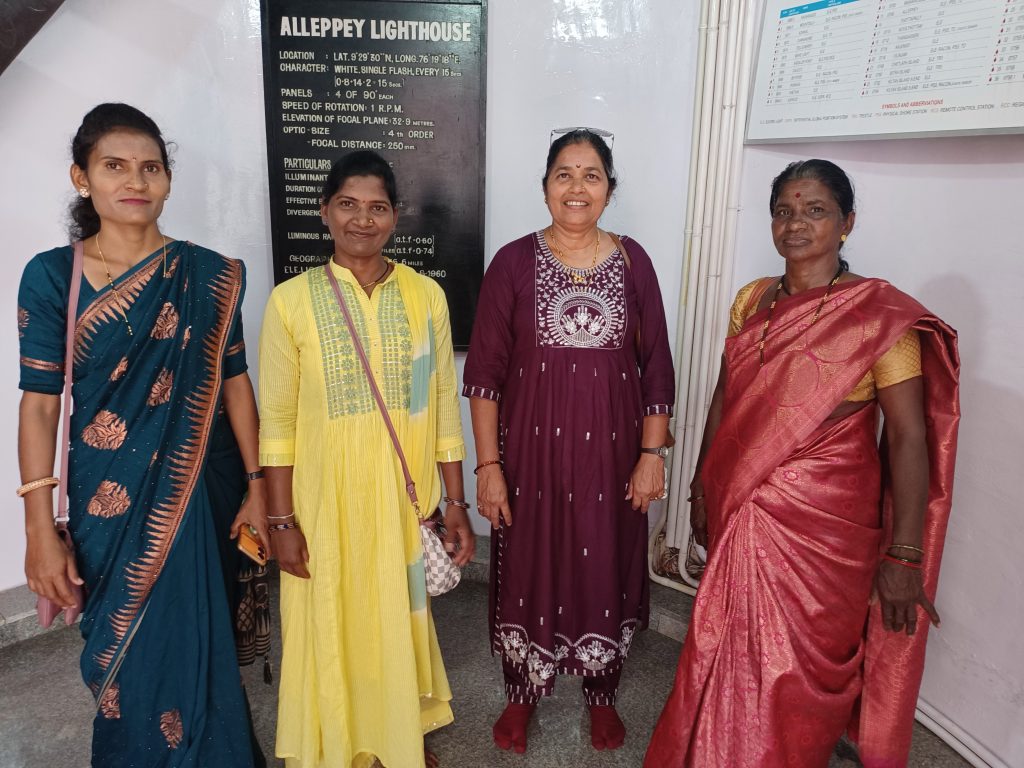
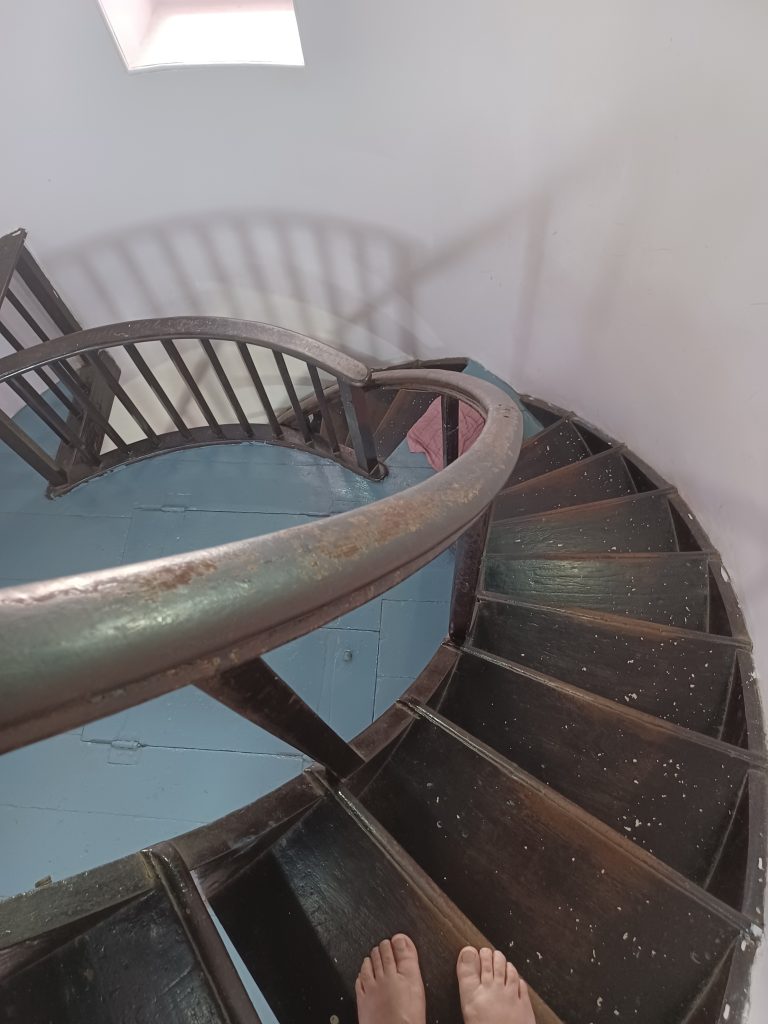
The final stop before Kochi is at an enticing beach just north of Alleppey. There are beach stalls there selling drinks. I buy coffee for me and Nishad for about 40 rupees before strolling alone on the white sands and paddling in the sea.
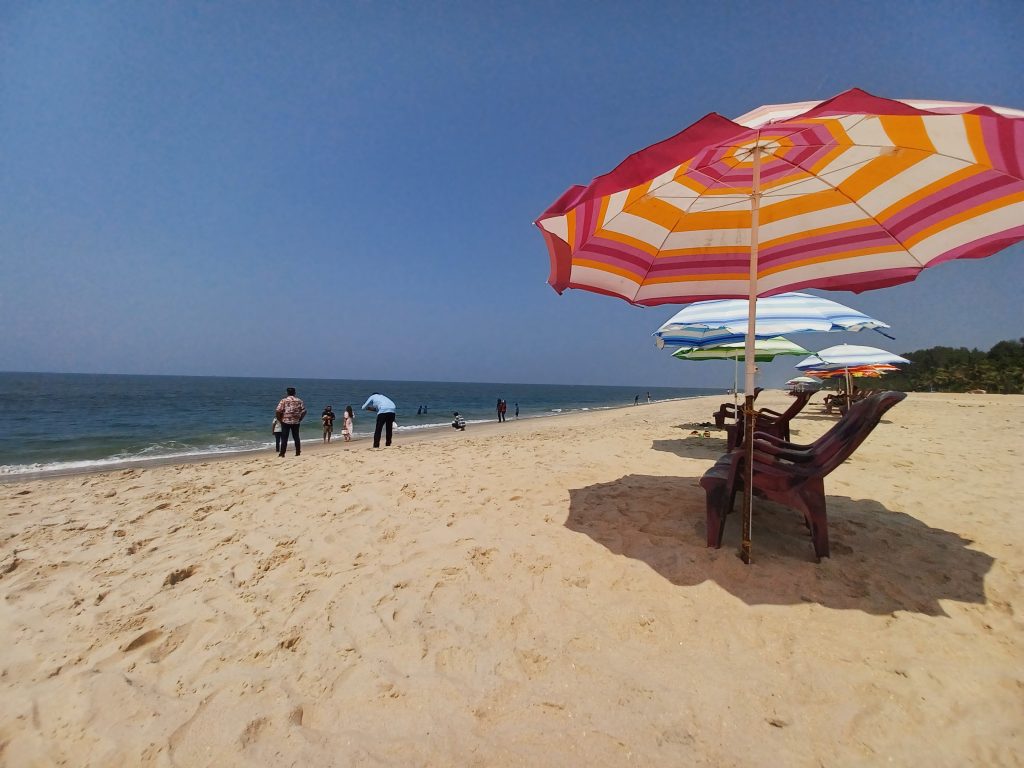
Lined up on the sand is a row of striped umbrellas under which are striped chairs. I sit on one and observe the scene. Families and couples are having fun. Some are swimming, some wandering, others taking pictures. A white group of egrets stands near the sea’s edge and some slight surf runs up the beach.
No holy cows lolling here (unlike Marina Beach in Chennai). I gather they are more restricted in their wanderings in Kerala State. A lady in a red sari approaches and collects a hundred rupees from me for using the chair. Fair enough. It is pleasant here. I have time to reflect. The journey has been something of an endurance test really. Not much chance to bask and dream or read or relax. I look into the distance. About 1500 nautical miles westwards across the Arabian Sea is the Arabian peninsula to which I will be heading after a few days. Wonder what adventures await me there. Eventually, resignedly, I ease myself off the chair and head up the beach, passing other stalls selling plastic trinkets, to join the car once more.
Kochi
The final destination of my journey across southern India is Kochi. It was the Portuguese who established a fort here ‒ Fort Cochin in 1503. It is rich in history and heritage with vestiges of the Portuguese, British, Arabs, Dutch, Chinese and Jews, and is fascinating. Just the sort of place that arouses my enthusiasm. Accompanied by the local guide I start off at the old Brunton boatyard, a former British shipyard, now a luxury hotel, painted white with red tiled roof and fringed by palm trees. From here I look across at the huge container port, southern India’s main port, and watch the car ferry set off, puffing smoke, to Vypin Island opposite. To the right is the large modern part of the city, Ernakulam, with its high rise blocks, and along the road in front is a row of giant rain trees, their extensive canopies providing shade. Ferns have established a foothold and sprout from the massive branches while up one trunk a fig tree furls.
To the left of the old shipyard is a row of Chinese fishing nets. These nets stand ten metres tall suspended on bamboo poles overhanging the water. They look a bit surreal. According to my guide, the Chinese came to India in 1461 and set them up both here and on Vypin island. We watch a couple of fishermen operating one of them. “This used to be done manually but today a small engine does the work”, my guide tells me. We watch the net dip down. “See the counterweight of stones going up here. They are tied on with ropes. They used to be coir, but are now plastic”. The huge contraption only catches a few fish which one of the fishermen scoops out. But over the day’s duration the catch must be pretty good. Perching upon the framework is an Indian pond heron and below it an egret, awaiting their chance. House crows screech in the trees above. The messy beach is covered with coconut debris, bits of old nets and a few black painted boats. They resemble Venetian gondolas. One of them is being pushed onto the water by its crew. Alongside the beach is a road full of reeking fish stalls selling mullet, squid, prawns and other products from the Arabian Sea.
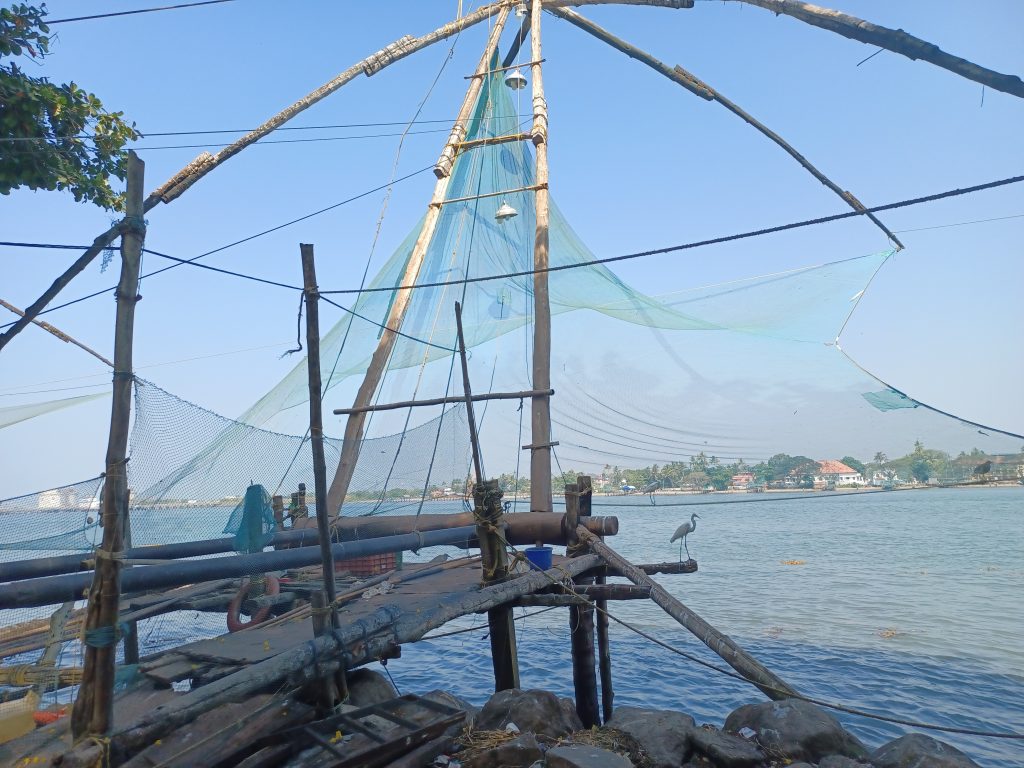
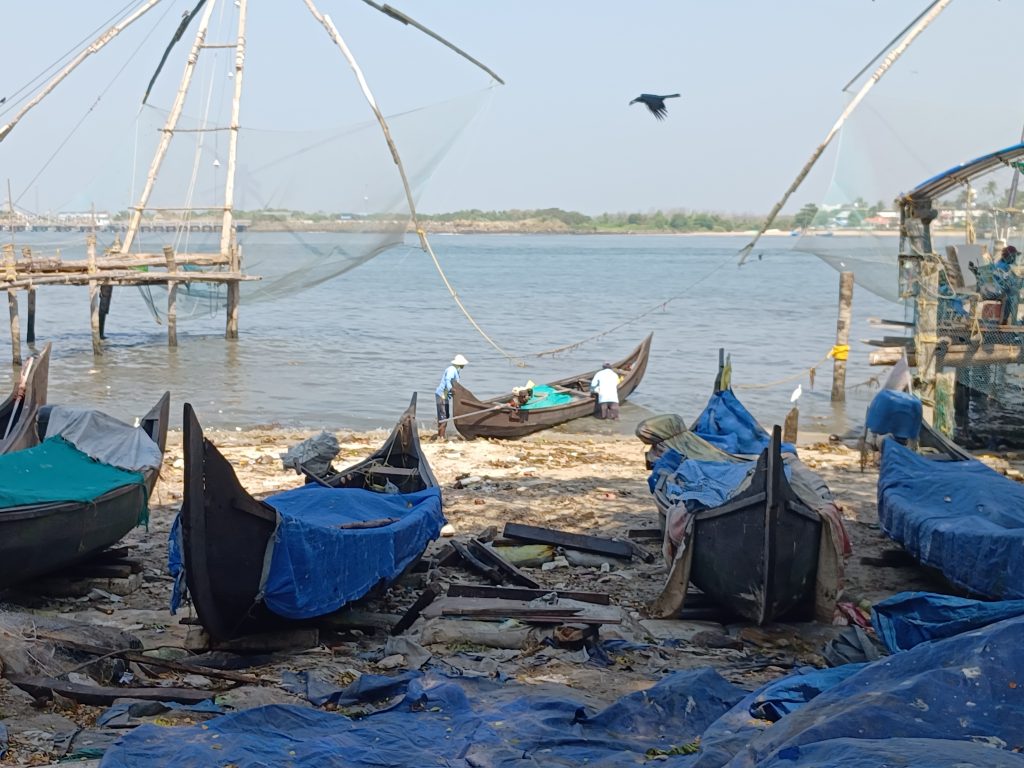
Farther along the road we pass the remnants of the old Portuguese fort, rebuilt later by the Dutch. Scarcely impressive now. Pass a rusty coloured rest house for government employees, then enter David Hall, a watering hole of the finest sort. Its rattan roof is supported by wooden uprights and crossbeams, bound with coir ropes. Pink Floyd music is being piped in the background to the mainly foreign clientele, happy to pay ten times as much for a drink here as they would from a beach stall. Musical events are sometimes held in David Hall and there is also an art gallery inside. I make a mental note to pop in here later on. We pop into St Francis Church, India’s oldest church, and see the tomb of Vasco da Gama, the famous Portuguese navigator, who found the sea route between Europe and India. “He died here but his bones are not here now. They were taken to Lisbon long ago,” I am told. The Church was taken over by the Dutch in 1663, then by the British in 1795 when it became an Anglican church. It is now the Church of Southern India.
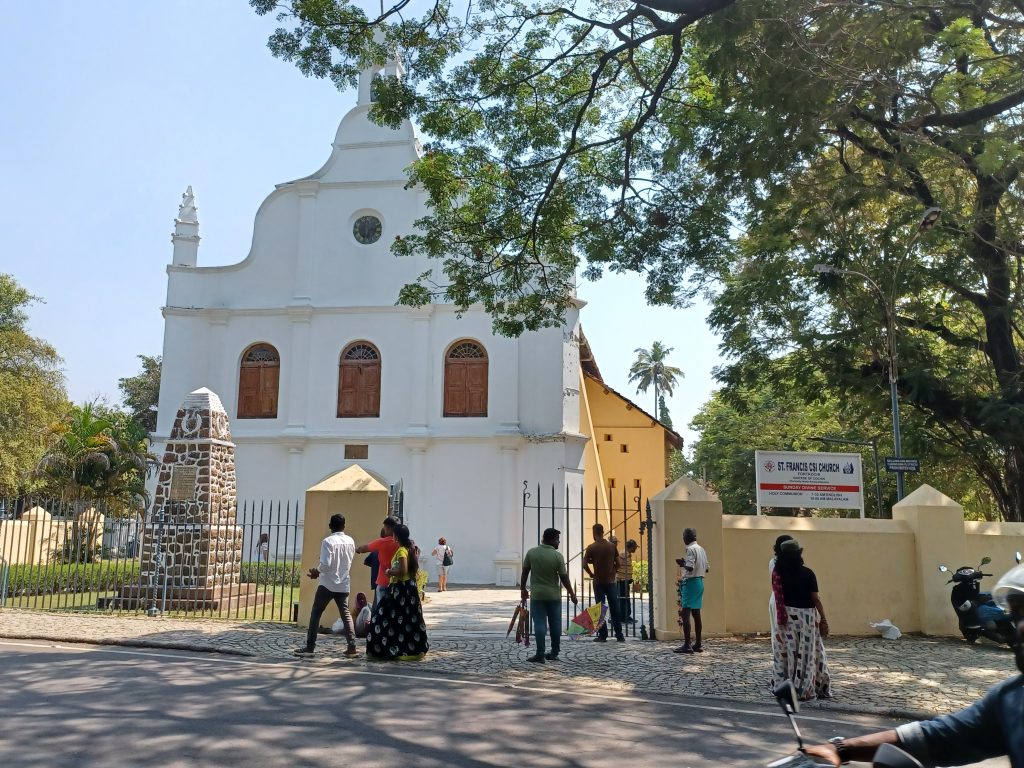
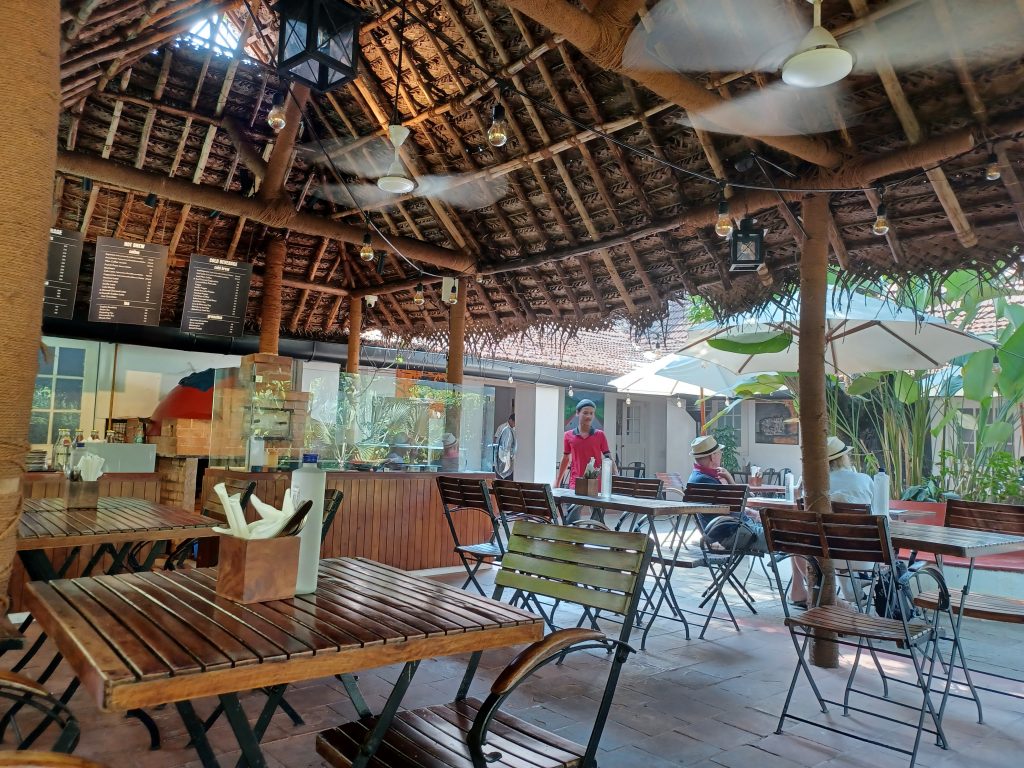
I see the stunning creamy coloured Santa Cruz Cathedral Basilica built by the Portuguese in 1558, demolished and rebuilt by the British in the early 1900s. Inside a group of Italians are taking hasty photographs before buzzing off. I, at least, have more time today to wander round the marble columns, aisles and arches. There is a painting of the Last Supper above the stained glass east window.
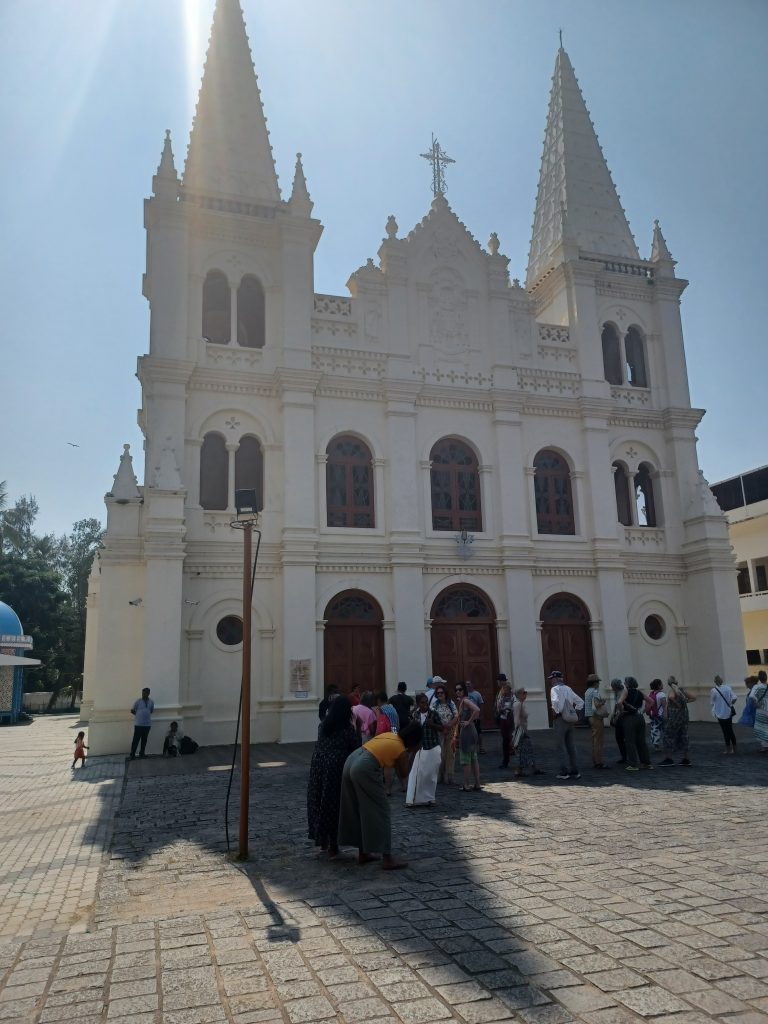
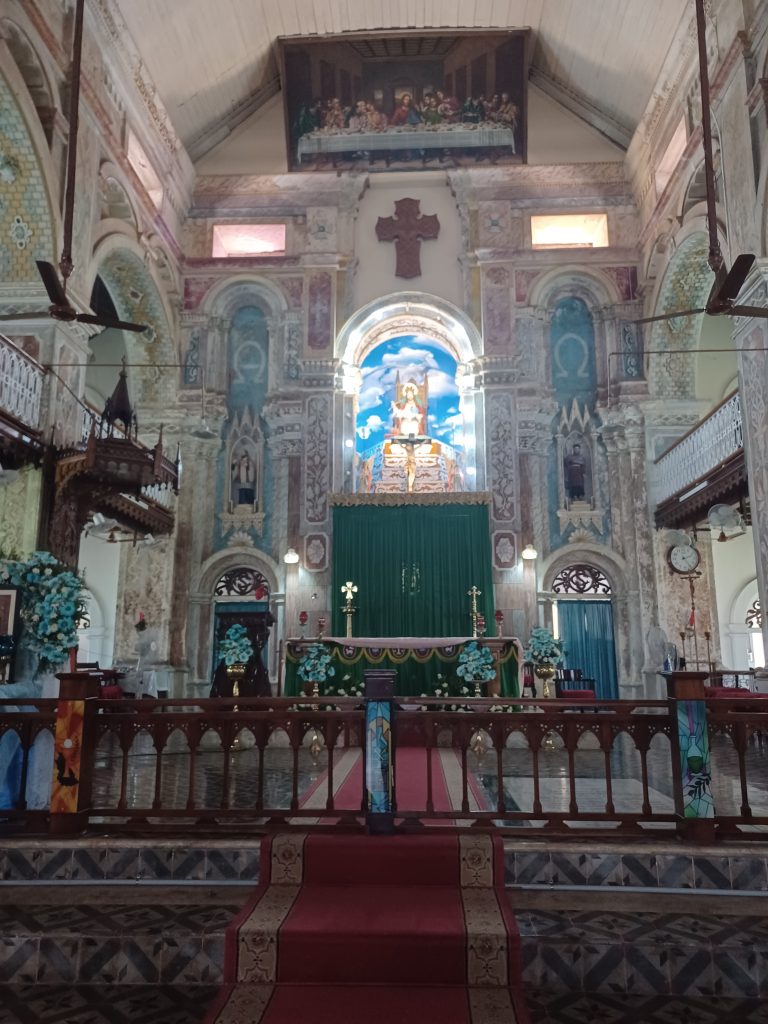
A short tuk-tuk ride away is Mattancherry where there is a palace, built by the Portuguese for the King of Kochi. We enter. Inside the walls are covered with murals depicting the Hindu epics, and the ceiling drips with carved teak throughout. Close by is an old Jewish synagogue, the Cochin Paradesi Synagogue, built in 1568, which has three clocks on the outside walls. My guide asks me if I can make out anything unusual about the clocks. Ah, the numerals are different. I recognise the Hebrew and Roman ones. “The third one is Malayalam.” Inside the synagogue are Chinese blue and white floor tiles. Relations with the Chinese were good before the Europeans came and monopolised the trade in the fifteenth century, I am told. There were good relations with the Arab traders too, who tolerated the Jewish presence here. They – the Jews – nevertheless departed after the Jewish state was formed in 1948 leaving behind an area known as Jew Town with big houses, many now converted to hotels and restaurants. The narrow streets are full of cafés and small shops selling antique furniture and curios, some of which, apparently, may once have belonged to them.
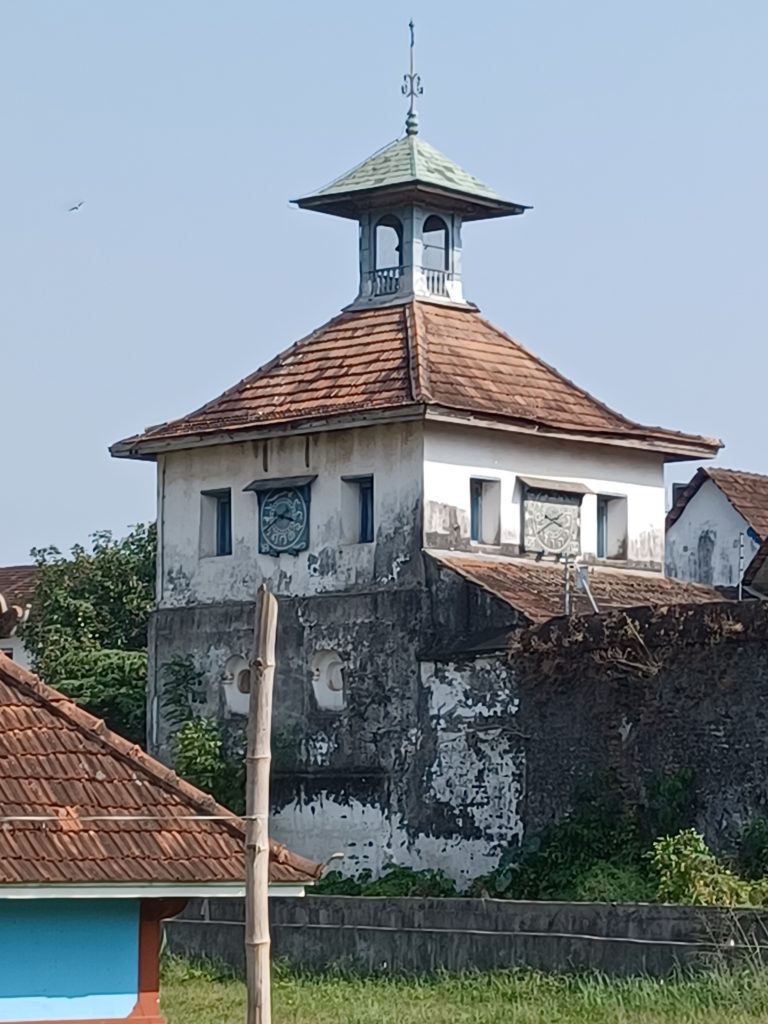
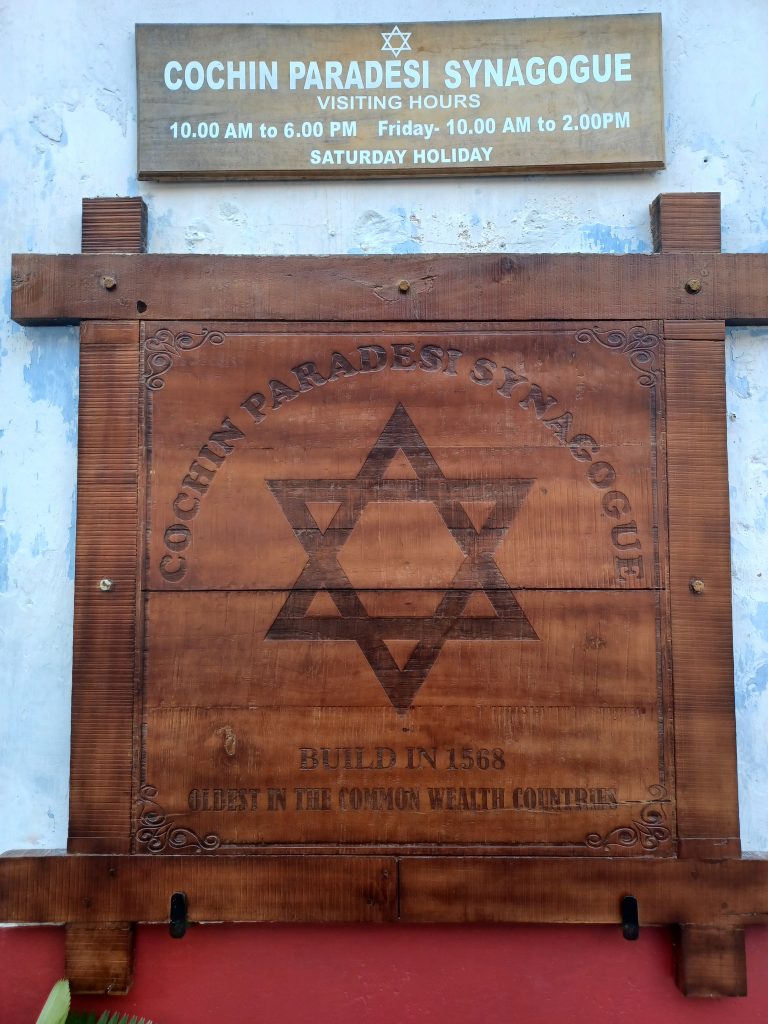
The guide takes his leave and I wander off to a restaurant by the water for tea. From here one can look across to Willingdon island reclaimed by the British to build a port in 1936. It is now home to the Kochi Naval Base. It was named after the then Viceroy of India, Lord Willingdon. I sip my tea slowly taking in the history of this place, while fans whizz round on the restaurant ceiling keeping all the Europeans cool.
I would have liked to spend many days here in Fort Kochi but my time is up. I may well return.

Leave a Reply